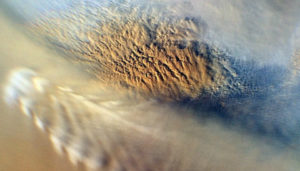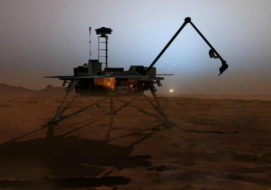Electrostatic discharge in a simulated Martian environment yields perchlorates — a potential energy source for microbial life — at abundances much greater than sunlight alone.

NASA / JPL-Caltech / Malin Space Science Systems
The huge concentrations of a potential energy source for life across the surface of Mars come from electricity generated in dust storms, according to new research.
Perchlorate ions — composed of one chlorine atom and four oxygen atoms — are highly toxic to many organisms, but a select number of microorganisms can use perchlorate as an energy source. So when NASA's Phoenix Mars lander discovered perchlorates in 2008 near its north-pole landing site, the find gave scientists some hope for eventually discovering Martian life.
Perchlorate is far more common on Mars than local geology would suggest, a fact that puzzled researchers for years. Mars has about 10 million times as much perchlorate in its soil than what would be generated naturally through sunlight. Some researchers previously suggested lightning could make the perchlorates, but this wasn't tested before now.
While testing the lightning idea, researchers led by Zhongchen Wu (Shandong University, China) came up with a new idea — electricity generated in dust storms — after creating a simulator of a Mars-like atmosphere, featuring low pressures and temperatures similar to those found on the Red Planet.
Martian atmospheric pressure is less than one percent of that on Earth, so Mars is unlikely to accumulate enough charged particles for lightning. However, Martian dust storms are plentiful, and dust devils on Earth are known to create electric fields. Electrostatic discharge can also happen more easily on the Red Planet.
The researchers conducted electrostatic discharge experiments within Mars-like temperatures and atmospheric pressure inside of an enclosed chamber. They found that interactions between the discharged electrons and Mars-like gas molecules instantaneously generated free radicals, which then oxidized rock salt to create chlorate, sodium carbonate, and . . . perchlorate. They also found that the yields of oxidized compounds from visible, high-electron-density discharges were more than 1,000 times that by photochemistry in their simulator, which translates to 10 million times on the planet itself.
Their research was published online October 15th in Earth and Planetary Science Letters.

JPL-Caltech / NASA/ Univ. Arizona
Louis Derry (Cornell University) says the authors have found a potentially viable way to produce the perchlorate seen on the surface.
"The study presents a very interesting mechanism for generating these highly oxidized compounds on the Martian surface,” says Derry, who was not involved in this research. “It has been difficult to achieve the apparent rate of production needed to explain the high abundance of these compounds on Mars using the same mechanism that operates on Earth, largely because the Martian atmosphere is too thin. . . . Hopefully follow-up studies will be able to address how to scale up the results from their experiments, to the Martian atmosphere and surface."
Co-author Alian Wang (Washington University, St. Louis) told Sky & Telescope that her team hopes someday to corroborate their theories with direct observations of electrostatic discharge on Mars.
There have been no missions yet — but not for lack of trying. Wang said one payload was supposed to fly on the cancelled 2001 NASA Mars Surveyor lander, while another crashed on the surface along with the rest of the 2016 European ExoMars Schiaparelli lander demonstrator.
"There is no electrical field measurement payload selected in the three near-term landing/roving missions to Mars, i.e., U.S. Mars 2020, Europe's ExoMars, and China's Mars 2020. So we have to wait," she said in an e-mail.
She also urged more electrical field measurements on other planetary bodies, to provide comparison measurements. Possible locations could be the Moon, Venus, and some of the larger moons in Jupiter's system.
Wang added that she has several more studies ongoing to learn more about electric fields on the Martian surface, as well as the possibility of habitability. She recently received a grant from the NASA Solar System program to study electrostatic-induced chemistry in Mars- and Venus-like conditions.
She also is interested in the possibility for life, as she is doing an ongoing study to examine how Mars-relevant hydrous salts are giving more information "on the potential paradise in the Martian subsurface" for microbes, Wang added.
Editor's Note: This story was updated November 9th to clarify what molecules were observed in the electrostatic discharge experiments and which processes led to their creation.
Reference:
Z. Wu et al. "Forming Perchlorates on Mars through Plasma Chemistry During Dust Events." Earth and Planetary Science Letters. October 15, 2018.
 0
0









Comments
You must be logged in to post a comment.